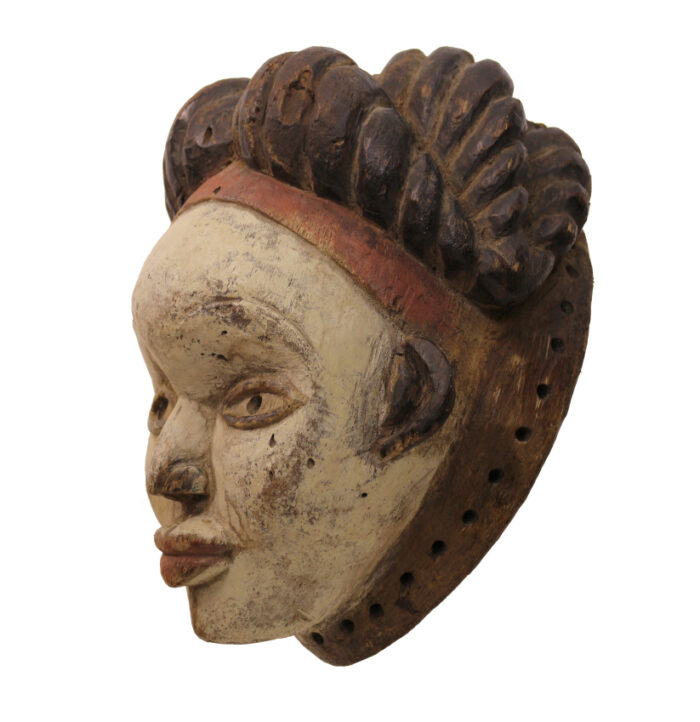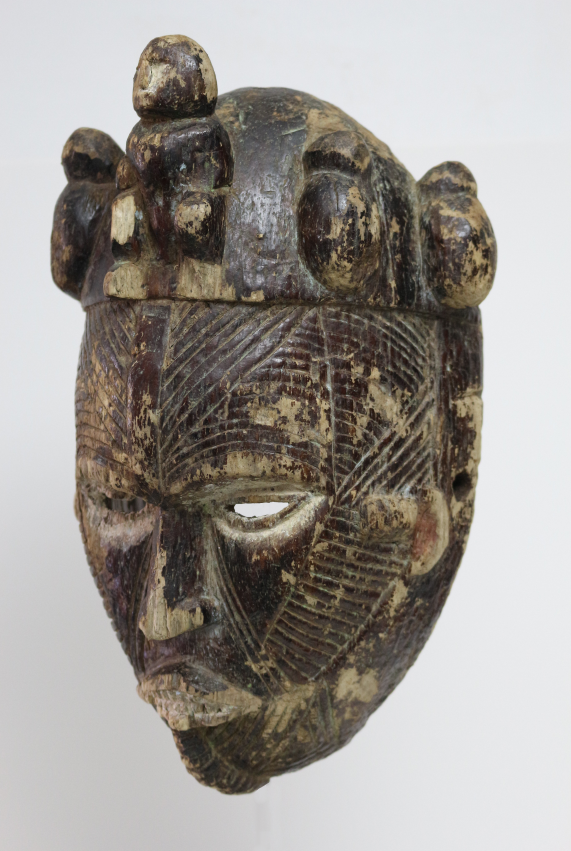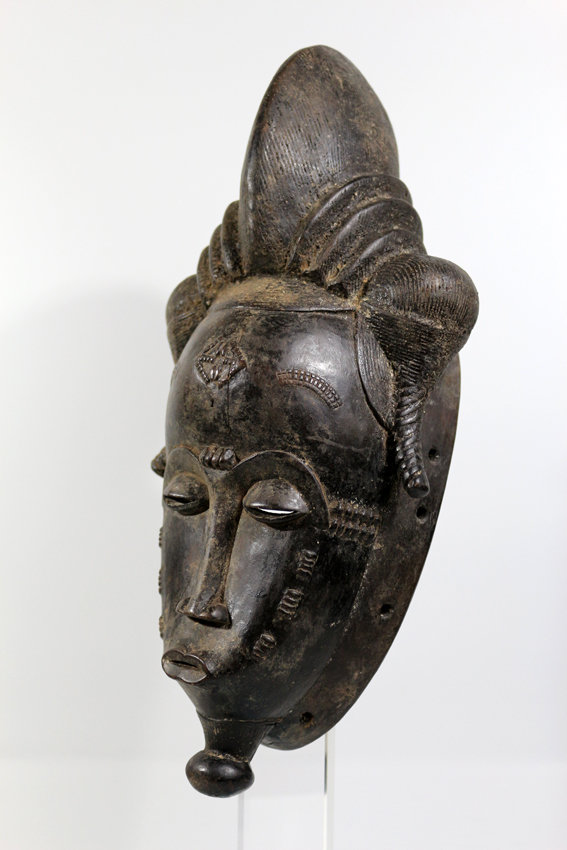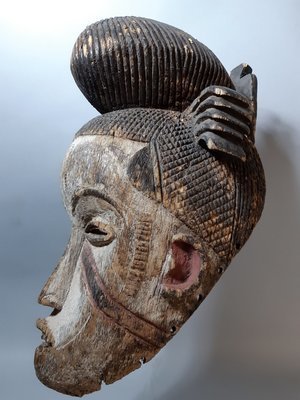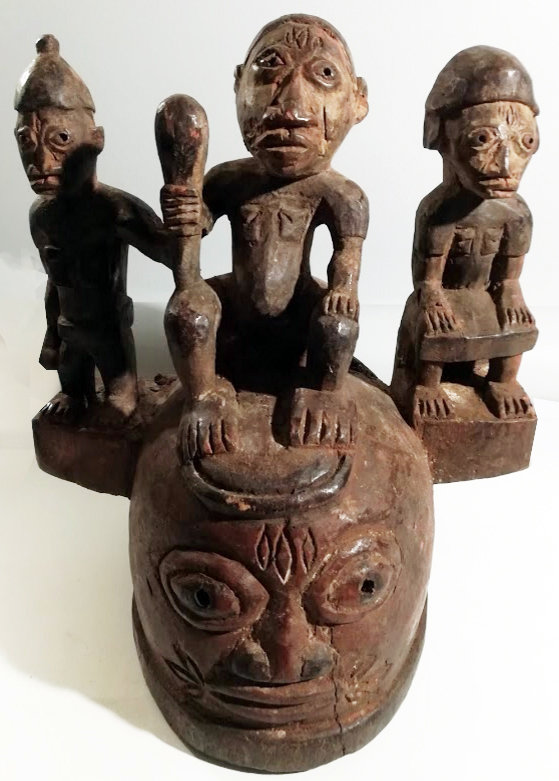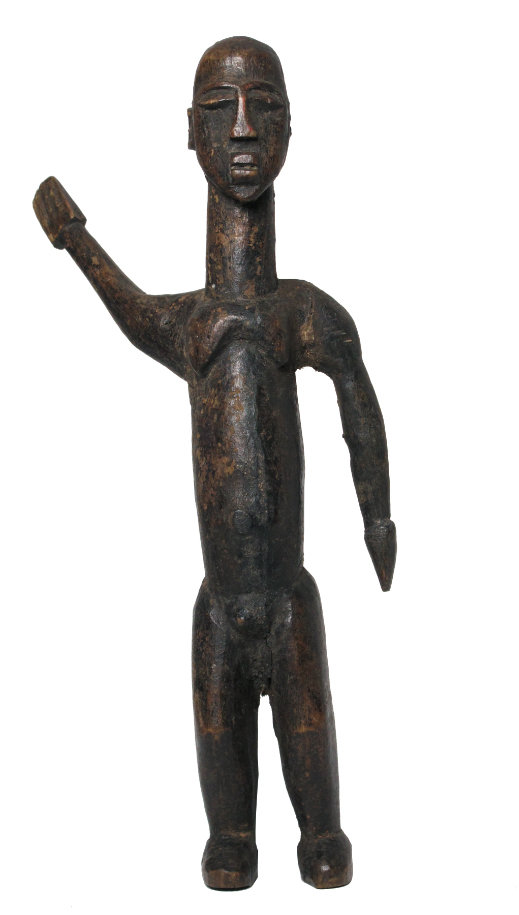-
Vue Rapide
Masque Punu, Gabon Afrique. Important masque Punu. Une belle coiffe ouvragée, une très bellle expression sereine font de ce masque une pièce exceptionnelle réservée à des dignitaire de haut rang. H. 33,5cm. ( Afrique, Art africain, Civilisation et ethnies).
-
Vue Rapide
Afrique. Masque Téké très érodé. Les Teke – ou Téké – sont des Bantous d’Afrique centrale répartis, pour l’essentiel de leur population, au sud, au nord et centre de la République du Congo. Bois, pigments. H. 30,5cm. (Afrique, Art africain, Civilisation et ethnies).
-
Vue Rapide
Masque zoomorphe à cornes Afrique. Beau masque zoomorphe à cornes. Probablement issu des régions limitrophes aux Ibibios (Nigéria). Les yeux sont surmontés de kaolin rafraîchi et les cornes se rejoignent à leurs sommets conférant à l’ensemble les attributs caractéristiques d’un masque initiatique de société secrète. Bois, Caolin. H. 38cm – (Afrique, Art africain, Civilisation et ethnies).
- Vue Rapide
- Vue Rapide
-
Vue Rapide€900,00
-
Vue Rapide€1.600,00
Ivory Coast, Baoulé mask
The Baoulés (Ba Ou li) are a people of Côte d’Ivoire, living mainly in the center of the country, near the cities of Bouaké and Yamoussoukro. They represent around 23% of the country’s population (around 3,943,667 individuals), which makes the Baoulés the first ethnic group in the country, ahead of the Betes and the Senoufos, who constitute the country’s second and third ethnic groups respectively. The Baoulés are part of the Akan group and are from neighboring Ghana. They settled in Ivory Coast in the 18th century, guided by Queen Abla Pokou. The name Baoulé comes from the sacrifice, by Queen Pokou, of one of her sons in order to cross a river, while she was leading the flight of her people from Ghana: ba ou li (the child is dead). The Baoulés settled between the Bandama and Comoé rivers.
***
Ivory Coast, Baule Mask
The Baoulés (Ba Ou li) are a people of Ivory Coast, living mainly in the center of the country, near the cities of Bouaké and Yamoussoukro. They represent about 23% of the population of the country (about 3,943,667 individuals) which makes Baoulés the first ethnic group of the country ahead of Betes and Senoufos which respectively constitute the second and third ethnic group of the country. The Baoulés are part of the Akan group and come from neighboring Ghana. They settled in Ivory Coast in the eighteenth century, guided by Queen Abla Pokou. The name Baoulé comes from the sacrifice, by queen Pokou, of one of her sons to cross a river, while she led the flight of her people from Ghana: ba or li (the child is dead). The Baoulés settled between the rivers Bandama and Comoé.
***
Elfenbeinküste, Baule-Maske
Die Baoulés (Ba Ou li) sind ein Volk der Elfenbeinküste, die hauptsächlich in der Mitte des Landes leben, in der Nähe der Städte Bouaké und Yamoussoukro. Sie repräsentieren etwa 23% der Bevölkerung des Landes (etwa 3 943 667 Personen), was Baoulés zur ersten ethnischen Gruppe des Landes vor Bêtes und Senoufos macht, die die zweite bzw. dritte ethnische Gruppe des Landes bilden. Die Baoulés gehören zur Akan-Gruppe und kommen aus dem benachbarten Ghana. Sie ließen sich im 18. Jahrhundert in der Elfenbeinküste unter der Führung von Königin Abla Pokou nieder. Der Name Baoulé kommt von der Opferung eines ihrer Söhne durch Königin Pokou, um einen Fluss zu überqueren, während sie die Flucht ihrer Leute aus Ghana führte: ba oder li (das Kind ist tot). Die Baoulés ließen sich zwischen den Flüssen Bandama und Comoé nieder.
- Vue Rapide
-
Vue Rapide€3.100,00The Idoma are an ethnolinguistic group that mainly inhabits the western regions of Benue, Nigeria, and related groups are found in Cross Rivers State, Enugu State and Nasarawa State in Nigeria. The Idoma language is classified in the Akweya subgroup of the idomoid languages of the Volta family – Niger, which includes the Alago, Agatu, Etulo and Yala languages of the Benue, Nasarawa and Northern Cross states. The Akweya subgroup is closely linked to the Yatye-Akpa subgroup. Most of the territory is inland, south of the Benue River, some seventy-two kilometers east of its confluence with the Niger River. The Idomas are known to be classy “warriors” and “hunters”, but welcoming and peace-loving. Most of the land of Idoma remained largely unknown in the West until the 1920s, leaving much of the colorful traditional culture of Idoma intact. The population of Idoma is estimated at around 4 million. The Idoma people have a traditional chief called Och’Idoma who is the head of the Traditional Council of the region of Idoma while each community has its own traditional chief such as Ad’Ogbadibo d’Orokam, chief of Enenche. The palace of the Och’Idoma complex is located in Otukpo, in the state of Benue. The Idoma people have a traditional chief called Och’Idoma who is the head of the Traditional Council of the region of Idoma while each community has its own traditional chief such as Ad’Ogbadibo d’Orokam, chief of Enenche. The palace of the Och’Idoma complex is located in Otukpo, in the state of Benue. The Idoma people have a traditional chief called Och’Idoma who is the head of the Traditional Council of the region of Idoma while each community has its own traditional chief such as Ad’Ogbadibo d’Orokam, chief of Enenche. The palace of the Och’Idoma complex is located in Otukpo, in the state of Benue.
-
Vue Rapide€1.100,00
-
Vue Rapide
Bateba statuette of the Lobi people, Burkina Faso
The Lobi live in southwestern Burkina Faso and northern Côte d’Ivoire and Ghana. they are extremely resistant to any form of centralized political authority. Instead their communities are based on the laws of God. The central figure in each Lobi community is the religious specialist named the Thildar. this soothsayer is responsible for communicating with the spirits that govern the community and protecting members of each family from accidents, illness, violence and all the multiple threats people encounter in the hostile environment of West Africa . The carved Lobi represent the spirits of nature they called Thil. Each of these figures displays different gestures or postures, some of them can have two or even three heads, some female figures carry a baby under the arm. These unique characteristics represent the particular talent or power of the spiritual being they embody. A figure raising an arm places a roadblock at the entrance of the malicious spirits at the family home.
H. 25cm. Male character whose pose reflects the Lobi aesthetic in its quality criteria. Standing, the right arm raised back, the left arm stretched out along the body. The forehead is high, the flat nose triangular and the male torso well pronounced. Sex and navel are prominent. The muscular legs have powerfully shaped calves. Hard and dense wood, very nice patina of use.
***
Bateba statuette of the Lobi people, Burkina Faso.
H. 25cm. Male character whose pose reflects the aesthetic Lobi in its quality criteria. Standing, the right brad raised back, the left arm at a distance stretched along the body. The forehead is high, the triangular flat nose and the pronounced male torso. Sex and navel are prominent. The muscular legs have powerful patterned knobs. Hard and dense wood, very beautiful patina of use.
***
Bateba Statuette der Lobi Leute, Burkina Faso.
H. 25cm. Männlicher Charakter, dessen Haltung den ästhetischen Lobi in seinen Qualitätskriterien widerspiegelt. Der rechte Brad hob sich zurück, der linke Arm streckte sich in einiger Entfernung über den Körper. Die Stirn ist hoch, die dreieckige flache Nase und der ausgeprägte männliche Torso. Sex und Nabel sind prominent. Die muskulösen Beine haben kräftige gemusterte Knöpfe. Hartes und dichtes Holz, sehr schöne Patina.
